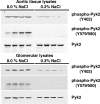Mechanism of dietary salt-mediated increase in intravascular production of TGF-beta1
- PMID: 18562633
- PMCID: PMC2519184
- DOI: 10.1152/ajprenal.90294.2008
Mechanism of dietary salt-mediated increase in intravascular production of TGF-beta1
Abstract
Clinical and preclinical studies have demonstrated an important effect of arterial pathobiology on the progressive loss of renal function that occurs in chronic kidney disease. Chronic kidney disease, in turn, promotes alterations in vascular function. A modulating role for dietary salt has been suggested, with the amount of salt intake regulating endothelial cell production of transforming growth factor-beta1 (TGF-beta1), a fibrogenic growth factor that promotes arteriosclerosis and glomerulosclerosis. The purpose of the present studies was to determine how the interaction between dietary salt intake and vasculature promoted the production of TGF-beta1 in rats. Two different vascular tissues, aortic rings and glomeruli, were chosen for study. Dietary salt induced, in a dose-dependent fashion, activation of proline-rich tyrosine kinase-2 (Pyk2) and further identified c-Src as an important binding partner of Pyk2 in these tissues. Use of pharmacological inhibitors and dominant negative strategies confirmed that dietary salt induced complex formation of Pyk2 and c-Src with downstream activation of p38 and p42/44 mitogen-activated protein kinases and generation of TGF-beta1. The experiments defined the molecular signaling events that promoted the production of TGF-beta1, a key growth factor involved in the vascular response to increased salt intake.
Figures











References
-
- Abe M, Harpel JG, Metz CN, Nunes I, Loskutoff DJ, Rifkin DB. An assay for transforming growth factor-beta using cells transfected with a plasminogen activator inhibitor-1 promoter-luciferase construct. Anal Biochem 216: 276–284, 1994. - PubMed
-
- Avraham H, Park SY, Schinkmann K, Avraham S. RAFTK/Pyk2-mediated cellular signalling. Cell Signal 12: 123–133, 2000. - PubMed
-
- Avraham S, London R, Fu Y, Ota S, Hiregowdara D, Li J, Jiang S, Pasztor LM, White RA, Groopman JE, Avraham H. Identification and characterization of a novel related adhesion focal tyrosine kinase (RAFTK) from megakaryocytes and brain. J Biol Chem 270: 27742–27751, 1995. - PubMed
-
- Becker-Hapak M, McAllister SS, Dowdy SF. TAT-mediated protein transduction into mammalian cells. Methods 24: 247–256, 2001. - PubMed
-
- Benstein JA, Feiner HD, Parker M, Dworkin LD. Superiority of salt restriction over diuretics in reducing renal hypertrophy and injury in uninephrectomized SHR. Am J Physiol Renal Fluid Electrolyte Physiol 258: F1675–F1681, 1990. - PubMed
Publication types
MeSH terms
Substances
Grants and funding
LinkOut - more resources
Full Text Sources
Medical
Miscellaneous

